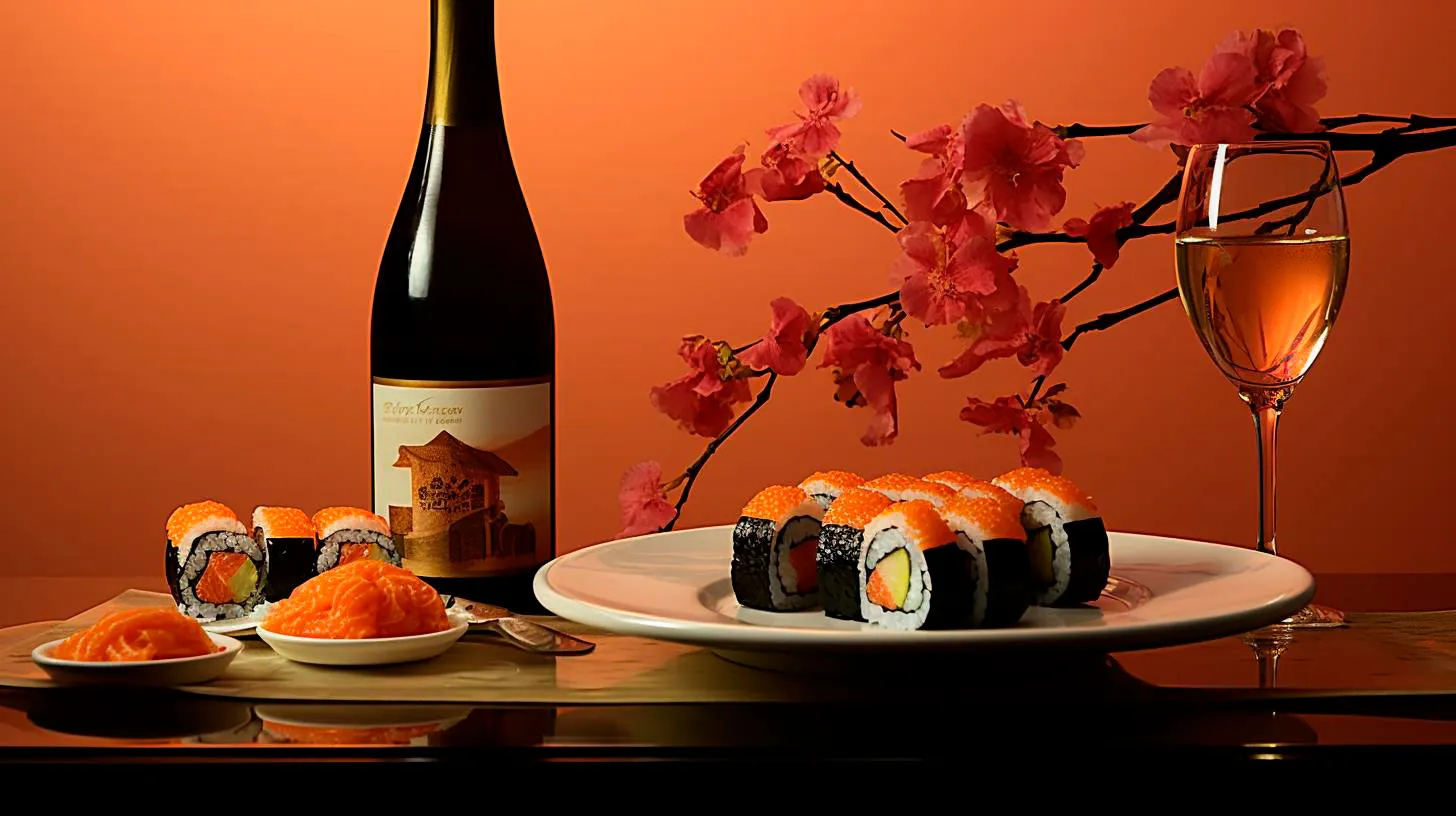From Nigiri to Maki: Discovering the Diverse World of Sushi Rolls
While many are familiar with the classic nigiri, there is a whole world of sushi rolls waiting to be explored. In this article, we will take a deep dive into the diverse world of sushi rolls and unravel the secrets behind their creation.
Sushi Rolls: A Brief Introduction
Sushi rolls, also known as makizushi, are a popular form of sushi where various ingredients are rolled inside a sheet of nori (seaweed) and served in bite-sized portions. The creativity and variety of flavors found in sushi rolls make them an exciting and enjoyable dining experience. Here are some key points to understand about sushi rolls:
- Sushi rolls come in a wide array of flavors and styles, each with its own unique combination of ingredients.
- Typically, sushi rolls consist of rice, seafood, vegetables, and other flavorful accompaniments.
- The roll is tightly wrapped using a bamboo mat called a makisu to create a cylindrical shape.
- Once the roll is complete, it is sliced into bite-sized pieces.
Types of Sushi Rolls
There is a vast range of sushi rolls available, each offering a different taste and texture. Let’s explore some popular types of sushi rolls:
1. Futomaki
Futomaki, meaning “thick roll” in Japanese, is a type of sushi roll that contains multiple ingredients. It often includes a combination of vegetables, cooked seafood, and eggs. Futomaki is typically larger in size compared to other sushi rolls and provides a satisfying and filling dining experience. Key takeaways:
- Futomaki consists of multiple ingredients, offering a variety of flavors and textures.
- It is a larger-sized sushi roll, making it a heartier option.
2. California Roll
The California roll is one of the most widely recognized sushi rolls outside of Japan. It was first created in Los Angeles, USA, and has become a favorite among sushi enthusiasts. The roll typically includes avocado, cucumber, crab meat, and mayonnaise. The rice is also rolled on the outside of the nori, adding a unique twist. Key takeaways:
- The California roll gained popularity outside of Japan and introduced sushi to a wider audience.
- It features a combination of avocado, cucumber, crab meat, and mayonnaise.
- The rice is on the outside, giving it a distinctive appearance.
3. Dragon Roll
The dragon roll is a visually striking sushi roll that often leaves a lasting impression. With its eel or shrimp tempura filling and avocado topping, it resembles the scales of a mythical dragon. The roll is typically garnished with spicy mayo or eel sauce, amplifying the flavors even further. Key takeaways:
- The dragon roll is visually appealing and resembles the scales of a dragon.
- It contains eel or shrimp tempura, avocado, and is often topped with spicy mayo or eel sauce.
- The combination of ingredients creates a unique and flavorful experience.
Health Benefits of Sushi Rolls
Aside from their delicious taste and variety, sushi rolls offer several health benefits. Here are some reasons why sushi rolls have gained a reputation as a wholesome dining choice:
- Sushi rolls are rich in omega-3 fatty acids, which are beneficial for heart health.
- They often include seaweed, which is a natural source of essential vitamins and minerals.
- Many sushi rolls feature fresh vegetables, providing a good dose of dietary fiber.
- They offer a balanced combination of proteins, carbohydrates, and healthy fats.
With their diverse flavors and health benefits, sushi rolls are a fantastic option for those seeking a delectable yet nutritionally balanced meal.
The Ever-Evolving World of Sushi Rolls
Sushi rolls continue to evolve and adapt to suit various taste preferences and dietary requirements. As sushi gains popularity worldwide, chefs and sushi enthusiasts are experimenting with new ingredients and techniques. Fusion sushi rolls, such as the popular sushi burrito and sushi pizza, fuse Japanese flavors with other culinary traditions. This innovative approach keeps the sushi roll scene vibrant and exciting, providing something for everyone.
The fusion of traditional and modern elements in sushi rolls has revolutionized the way we perceive and enjoy this beloved dish. It is a testament to the culinary creativity that has made sushi a global sensation.
Conclusion
Sushi rolls offer an enticing culinary journey filled with diversity, flavor, and health benefits. From traditional rolls like futomaki to the fusion creations of the modern sushi world, there is no shortage of options to explore. Whether you’re a sushi aficionado or a curious food lover, sushi rolls provide an unending adventure that will captivate your taste buds and leave you craving for more. So, next time you’re in a sushi restaurant, dare to venture beyond nigiri and dive into the vibrant and diverse world of sushi rolls.
Health Benefits Unveiled: Why Sushi Is a Nutritional Powerhouse
In this article, we will dive deep into the health benefits of sushi and uncover why it should be a part of your balanced diet.
1. Rich Source of Omega-3 Fatty Acids
One of the key reasons why sushi is considered a nutritional powerhouse is its high content of omega-3 fatty acids. These essential fats play a crucial role in reducing inflammation, supporting brain function, and promoting heart health. Omega-3 fatty acids are linked to a reduced risk of heart disease, lowered blood pressure, and improved cognitive function.
- Sushi rolls containing fatty fish like salmon, tuna, and mackerel are excellent sources of omega-3 fatty acids.
- Incorporating sushi into your diet can help meet your daily recommended intake of these essential fats.
2. Abundant in Vitamins and Minerals
Sushi is loaded with various vitamins and minerals that are vital for maintaining good health. These include:
- Vitamin B12: Essential for red blood cell production and nerve function.
- Vitamin D: Important for bone health, immune system function, and mood regulation.
- Iodine: Crucial for thyroid function and metabolism.
- Iron: Necessary for oxygen transportation and prevention of anemia.
- Potassium: Helps regulate blood pressure and support heart health.
By enjoying a sushi meal, you can incorporate these important nutrients into your diet, helping your body function optimally and preventing potential deficiencies.
3. High-Quality Protein Source
Sushi is an excellent source of high-quality protein, making it a great addition to any diet, including those following a vegetarian or vegan lifestyle. The fish and seafood used in sushi provide essential amino acids that your body needs for muscle growth, tissue repair, and overall health. Protein is also known to keep you feeling full and satisfied for longer periods, which can aid in weight management.
4. Low in Calories and Fat
If you are watching your calorie intake or trying to lose weight, sushi can be a great option. Traditional sushi rolls made with fish, vegetables, and rice are generally low in calories and fat. The use of minimal oil and cooking methods, such as steaming and grilling, helps preserve the nutritional value of the ingredients without adding unnecessary calories. However, it’s essential to be mindful of condiments like soy sauce and mayonnaise, which can increase the calorie and fat content of your sushi meal if consumed excessively.
5. Antioxidant-Rich Ingredients
Sushi often includes various antioxidant-rich ingredients like seaweed, ginger, and wasabi. These components possess powerful antioxidant properties that help protect your body against damage caused by harmful free radicals. Antioxidants are known for their potential to reduce the risk of chronic diseases, including cancer, heart disease, and inflammation.
Key Takeaways
- Sushi is a nutritional powerhouse, providing a wide range of health benefits.
- It is an excellent source of omega-3 fatty acids, essential for heart and brain health.
- Sushi is rich in vitamins and minerals, including B12, D, iodine, iron, and potassium.
- It serves as a high-quality protein source, aiding in muscle growth and repair.
- With its low calorie and fat content, sushi can be a part of a well-balanced diet for weight management.
- The antioxidant-rich ingredients in sushi help protect against chronic diseases.
Next time you crave a flavorful and nutritious meal, consider sushi as a delicious option that not only satisfies your taste buds but also provides a host of health benefits. Remember to choose a reputable sushi restaurant to ensure the freshness and quality of the ingredients. Embrace the world of sushi and unlock the potential of this nutritional powerhouse for your well-being.
Sushi for All: Debunking Common Myths and Misconceptions
Myth 1: Sushi is only raw fish
One of the most common misconceptions about sushi is that it is solely raw fish. While raw fish, known as sashimi, is indeed a part of sushi, it is important to note that sushi encompasses a lot more. Sushi refers to a combination of vinegared rice and various ingredients such as seafood, vegetables, and sometimes even cooked elements. This means there are plenty of options for everyone, including those who prefer not to consume raw fish.
Key takeaway: Sushi offers a range of options, making it suitable for individuals with different dietary preferences.
Myth 2: Sushi is not filling
Another myth surrounding sushi is that it leaves you hungry due to its small serving sizes. While sushi pieces can indeed be small, the meal as a whole can be quite filling. Sushi is often served as a combination of rolls, nigiri, and sashimi, allowing you to customize your meal to fit your appetite. Moreover, sushi is usually accompanied by sides such as miso soup, edamame, and pickled ginger, which add to the overall satisfaction of the dining experience.
Key takeaway: Sushi can be a satisfying and filling meal, especially when accompanied by complementary side dishes.
Myth 3: Sushi is not healthy
There is a common misconception that sushi is not a healthy option due to its association with fried or heavily sauced rolls. While some sushi rolls may indeed be higher in calories or fat content, it’s important to remember that sushi can also be a nutritious choice. Sashimi, for example, is a low-calorie option packed with essential nutrients like omega-3 fatty acids. Additionally, sushi frequently includes nutrient-rich ingredients like seaweed, fish, avocado, and vegetables.
Key takeaway: Sushi can be a healthy choice if you opt for options that include nutrient-rich ingredients and avoid heavily sauced or fried rolls.
Myth 4: Sushi is expensive
While it is true that high-end sushi restaurants can be quite costly, sushi can also be enjoyed at affordable prices. Many sushi establishments offer budget-friendly options like lunch specials or conveyor belt sushi, where plates of sushi pass by on a conveyor belt and are priced accordingly. In addition, making sushi at home can be a cost-effective alternative, allowing you to save money while experimenting with different ingredients and flavors.
Key takeaway: Sushi can be enjoyed without breaking the bank, with affordable options available at various sushi joints and the possibility of making it at home.
Myth 5: Sushi is difficult to make
Contrary to popular belief, making sushi at home can be a fun and rewarding experience. While the art of creating intricately rolled sushi may require practice, there are simpler sushi recipes that beginners can try. All you need is sushi rice, a few ingredients of your choice, and a bamboo sushi mat. Numerous online tutorials and resources are available to guide you through the process, making it more accessible than ever before.
Key takeaway: Making sushi at home can be a enjoyable and fulfilling activity, with plenty of resources available to help you master the art.
Final Thoughts
Sushi is a versatile and exciting cuisine that offers something for everyone. By debunking common myths surrounding sushi, we hope to encourage more people to explore and enjoy this Japanese delicacy. Whether you prefer raw fish, cooked ingredients, or vegetarian options, sushi has the ability to provide a unique and enriching dining experience. So next time you have the opportunity, give sushi a try and let your taste buds indulge in this delicious and culturally significant cuisine.
Exploring the Origins: Unveiling the Rich History of Sushi
In this article, we take a deep dive into the incredible journey of sushi, from its humble beginnings to its worldwide fame.
The Beginnings of Sushi
The story of sushi begins in Southeast Asia with a preservation technique known as “narezushi.” In ancient times, fish was packed with rice and then fermented to preserve it during the journey. The rice was then discarded, and the fish consumed separately. This method eventually made its way to Japan around the 8th century, evolving into what we now know as sushi.
During the Muromachi period in the 14th century, a new method called “nigirizushi” emerged. This style involved forming a small oblong rice ball and placing a thin slice of fish on top, incorporating the flavors of both rice and fish. It was during this period that sushi gained significant popularity among the samurai class in Japan.
The Rise of Edo-Mae Sushi
In the 19th century, the bustling streets of Edo (now known as Tokyo) became the birthplace of a new sushi culture, called Edo-Mae sushi. This style was an evolution of nigirizushi, with chefs utilizing fresh seafood from Tokyo Bay and its surroundings. With advancements in transportation, the fish could reach Edo swiftly, ensuring the finest quality and taste.
In Edo-Mae sushi, the rice was seasoned with vinegar, giving it a distinct flavor that complemented the raw fish. Sushiya (sushi shops) began popping up around Edo, allowing ordinary people to savor this delectable dish for the first time. This marked the turning point when sushi transitioned from being a street food to a culinary art form.
Sushi Spreads across Japan and Beyond
In the early 20th century, sushi started spreading across Japan, transcending region-specific styles. New creations like “Chirashizushi” (a bowl of seasoned rice adorned with a colorful assortment of fish, vegetables, and egg) and “Makizushi” (rolled sushi with seaweed) became popular alternatives to traditional nigirizushi.
After World War II, Japan saw a surge in sushi consumption, with sushi bars (known as “sushi-ya”) rapidly opening across the country. Diners could now enjoy various sushi styles, including the beloved “Omakase,” where the chef creates a personalized tasting menu based on the freshest ingredients available.
Fast forward to the present day, sushi has become one of the most sought-after cuisines worldwide. It has undergone countless adaptations to cater to diverse tastes and preferences. From traditional sushi made by skilled artisans to sushi conveyor belt restaurants, the options are endless, making it accessible to people from all walks of life.
The Key Takeaways
- Sushi originated from the preservation technique known as “narezushi” in Southeast Asia.
- The Edo-Mae sushi style became popular in Tokyo during the 19th century, utilizing fresh seafood from Tokyo Bay.
- Sushi has evolved to include various styles, such as nigirizushi, chirashizushi, and makizushi.
- Modern sushi offers diverse options, from traditional sushi-ya experiences to conveyor belt sushi restaurants.
Next time you savor a delectable piece of sushi, remember the fascinating journey this dish has taken throughout history. From its humble beginnings as a preservation technique to its status as a culinary art form, sushi continues to captivate taste buds around the globe. So, whether you’re a sushi aficionado or trying it for the first time, enjoy every bite with newfound appreciation for this truly remarkable creation.


